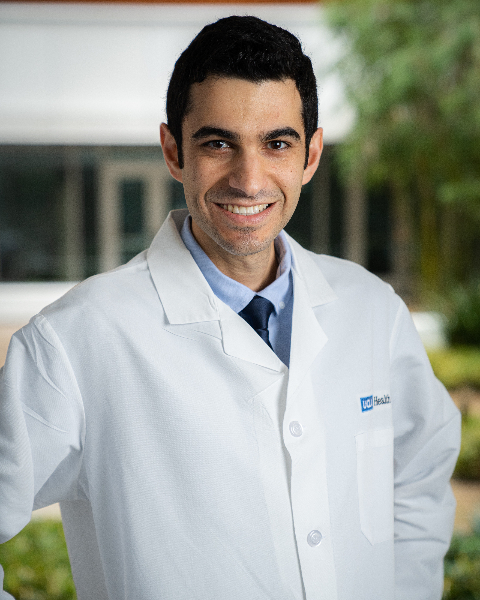SS 26 - Sarcoma 1: Optimizing Treatment Outcomes in Soft Tissue Sarcoma and Melanoma
247 - A Phase II Trial of 5-Day Neoadjuvant Radiation Therapy for Patients with High-Risk Primary Soft Tissue Sarcoma: Long-Term Follow-Up and Outcomes
Monday, September 30, 2024
5:00 PM - 5:10 PM ET
Location: Room 143

John Nikitas, MD
UCLA Radiation Oncology
Los Angeles, CA
Presenter(s)
J. Nikitas1, J. Kendal2, R. R. Savjani1, N. J. Jackson3, J. Deng1, J. Hernandez1, N. Chong1, B. Kadera4, J. Crompton4, L. Wessel2, B. Chmielowski5, A. S. Singh5, S. D. Nelson6, S. M. Dry6, J. B. Weidhaas1, M. L. Steinberg1, N. M. Bernthal2, F. C. Eilber4, A. Kalbasi7, and V. Reddy1; 1Department of Radiation Oncology, University of California, Los Angeles, Los Angeles, CA, 2Department of Orthopaedic Surgery, University of California, Los Angeles, Santa Monica, CA, 3Department of Medicine Statistics Core, University of California, Los Angeles, Los Angeles, CA, 4Department of Surgical Oncology, University of California, Los Angeles, Los Angeles, CA, 5Division of Hematology-Oncology, Department of Medicine, University of California, Los Angeles, Los Angeles, CA, 6Department of Pathology and Laboratory Medicine, University of California, Los Angeles, Los Angeles, CA, 7Department of Radiation Oncology, Stanford University School of Medicine, Stanford, CA
Purpose/Objective(s): Preoperative radiation therapy (RT) remains an integral part of management in the treatment of high-risk soft tissue sarcomas (STS). Conventional five-week RT can be burdensome and costly for patients. We conducted a single-institution, phase II study of dose equivalent, 5-day preoperative RT for high-risk primary STS and report long-term results. Materials/
Methods: This was a single-arm, phase II prospective trial enrolling patients with histologically confirmed extremity or trunk STS who planned to undergo preoperative RT (30 Gy in 5 daily fractions) followed by surgery. The primary endpoint was two-year grade =2 radiation morbidity. Radiation fibrosis and joint stiffness were graded using RTOG and EORTC criteria. Lymphedema was graded using Sterns scale. Secondary endpoints included rates of major wound complications, local control, freedom from distant metastasis (FFDM), and overall survival (OS).
Results: One hundred and ten patients were treated between April 2016 and February 2023. Median post-RT follow-up was 37.3 months (interquartile range [IQR]: 20.1-60.6 months) for all patients and 44.6 months (IQR, 28.2-65.5 months) for all evaluable patients. On biopsy, 59 tumors (53.6%) were grade 3, 32 (29.1%) were grade 2, 7 (6.4%) were grade 1, and 12 (10.9%) were not otherwise specified or did not meet conventional grading criteria. Median resected tumor size was 7.4 cm (IQR: 5.1-11.3 cm). 89 resections (80.9%) were R0, 18 (16.4%) were R1, and 3 (2.7%) were R2. Among patients with =2 years of follow-up (N = 74), the overall 2-year grade =2 toxicity rate was 18.9%. Rates of grade =2 fibrosis, joint stiffness, and edema were 12.2%, 12.2%, and 4.1%, respectively. Among all patients (N = 110), major wound complications occurred in 33 patients (30.0%). 2-year and 5-year local control rates were 91.7% (95% CI: 86.2-97.2%) and 85.7% (95% CI: 77.3-94.1%), respectively. 2-year and 5-year FFDM rates were 80.1% (95% CI: 72.1-88.1%) and 69.6% (95% CI: 58.2-81.0%), respectively. 2-year and 5-year OS rates were 84.0% (95% CI: 76.7-91.3%) and 76.1% (95% CI: 66.7-85.5%), respectively. Limitations include lacking randomization with a five-week RT course, which remains an ongoing challenge given rarity of STS.
Conclusion: Five-day preoperative radiotherapy for patients with extremity or trunk STS demonstrates acceptable rates of radiation fibrosis, joint stiffness, and edema, as well as favorable long-term local control and overall survival.
Purpose/Objective(s): Preoperative radiation therapy (RT) remains an integral part of management in the treatment of high-risk soft tissue sarcomas (STS). Conventional five-week RT can be burdensome and costly for patients. We conducted a single-institution, phase II study of dose equivalent, 5-day preoperative RT for high-risk primary STS and report long-term results. Materials/
Methods: This was a single-arm, phase II prospective trial enrolling patients with histologically confirmed extremity or trunk STS who planned to undergo preoperative RT (30 Gy in 5 daily fractions) followed by surgery. The primary endpoint was two-year grade =2 radiation morbidity. Radiation fibrosis and joint stiffness were graded using RTOG and EORTC criteria. Lymphedema was graded using Sterns scale. Secondary endpoints included rates of major wound complications, local control, freedom from distant metastasis (FFDM), and overall survival (OS).
Results: One hundred and ten patients were treated between April 2016 and February 2023. Median post-RT follow-up was 37.3 months (interquartile range [IQR]: 20.1-60.6 months) for all patients and 44.6 months (IQR, 28.2-65.5 months) for all evaluable patients. On biopsy, 59 tumors (53.6%) were grade 3, 32 (29.1%) were grade 2, 7 (6.4%) were grade 1, and 12 (10.9%) were not otherwise specified or did not meet conventional grading criteria. Median resected tumor size was 7.4 cm (IQR: 5.1-11.3 cm). 89 resections (80.9%) were R0, 18 (16.4%) were R1, and 3 (2.7%) were R2. Among patients with =2 years of follow-up (N = 74), the overall 2-year grade =2 toxicity rate was 18.9%. Rates of grade =2 fibrosis, joint stiffness, and edema were 12.2%, 12.2%, and 4.1%, respectively. Among all patients (N = 110), major wound complications occurred in 33 patients (30.0%). 2-year and 5-year local control rates were 91.7% (95% CI: 86.2-97.2%) and 85.7% (95% CI: 77.3-94.1%), respectively. 2-year and 5-year FFDM rates were 80.1% (95% CI: 72.1-88.1%) and 69.6% (95% CI: 58.2-81.0%), respectively. 2-year and 5-year OS rates were 84.0% (95% CI: 76.7-91.3%) and 76.1% (95% CI: 66.7-85.5%), respectively. Limitations include lacking randomization with a five-week RT course, which remains an ongoing challenge given rarity of STS.
Conclusion: Five-day preoperative radiotherapy for patients with extremity or trunk STS demonstrates acceptable rates of radiation fibrosis, joint stiffness, and edema, as well as favorable long-term local control and overall survival.
